Home > Digitized Walters Manuscripts
This document is a tranformation of a TEI P5 XML manuscript description incorporating images. If you have trouble reading special or non-Latin characters on this page, please make sure you have appropriate Unicode fonts installed and an up-to-date web browser.
Walters Ms. W.563, Koran
Browse images (Browse images in a new window) | TEI in XML format
W.563
Koran
Vernacular: القرآن
This large-format, illuminated Timurid copy of the Qur’an is believed to have been produced in Northern India in the ninth century AH / fifteenth CE. The manuscript opens with a series of illuminated frontispieces. The main text is written in a large, vocalized polychrome muḥaqqaq script. Marginal explanations of the readings of particular words and phrases are in thuluth and naskh scripts, and there is interlinear Persian translation in red naskh script. The fore-edge flap of the gold-tooled, brown leather binding is inscribed with verses 77 through 80 from Chapter 56 (Sūrat al-wāqiʿah). The seal of Sultan Bayezid II (886–917 AH / 1481-1512 CE) appears on fol. 8a. There is an erased bequest (waqf) statement and stamp of Sultan ʿUthmān Khān (432-6 AH / 1027-31 CE) on fol. 3a.
9th century AH / 15th CE
Northern India
Book
Scriptural
The primary language in this manuscript is Arabic. The secondary language of this manuscript is Persian.
Paper
Thin laid paper with some chain lines visible
Foliation: 552
Foliation skips a leaf between 316 and 317, and therefore is numbered 1 through 551. Fols. 550b-551b blank
31.0 cm wide by 40.0 cm high
19.5 cm wide by 26.0 cm high
- Columns: 1
- Ruled lines: 9
- Framing lines in black, blue, and gold
- Title: al-Qurʾān
- Text note: Explanations of the various readings of words and phrases in the margins; Persian interlinear translation
- Hand note: Written in three scripts throughout: 1. vocalized polychrome (black, gold, red, and blue) muḥaqqaq script, mainly for the Qur'anic text within the frame 2. thuluth script for some chapter headings (in gold or white) or Qur'anic words in the margins 3. naskh script for the Persian interlinear translation (in red) and explanations in the margins
- Decoration note: Series of illuminated frontispieces; double-page illuminated incipits; illuminated chapter headings; various illuminated marginal devices
fol. 2a:
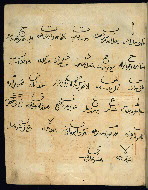
- Title: Letters of the alphabet with explanations
- Form: Text page
- Label: On this page are inscribed the letters of the alphabet with phrases that explain their esoteric (mystical) meanings.
fol. 3a:
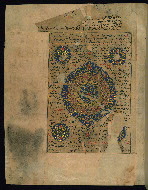
- Title: Illuminated frontispiece
- Form: Frontispiece
- Label: This restored, illuminated frontispiece was probably once part of a double-page composition. It bears a central medallion with pendants flanked by four smaller roundels. Notes in Persian and Arabic concerning the recitation of some Qur'anic passages are inscribed all over the page.
fol. 3b:
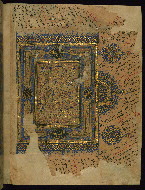
- Title: Double-page illuminated frontispiece
- Form: Frontispiece
- Label: This is the right side of a double-page illuminated frontispiece that is inscribed with the names of the seven reciters (qurrā’) of the Qur’an and their transmitters (in gold) with twenty-one abbreviations (in blue) assigned to them according to the alpha-numerical system (abjad). The inscription in the upper and lower cartouches reads: asāmī al-qurrāʾ al-sabʿ wa-riwāyatuhum. The margins contain explanations of the number of readings in various chapters according to various reciters.
fol. 4b:
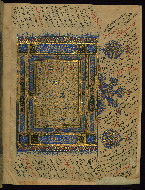
- Title: Double-page illuminated frontispiece
- Form: Frontispiece
- Label: This is the right side of a double-page illuminated frontispiece that is inscribed with the names of the seven reciters (qurrā’) of the Qur’an and their transmitters (in gold) with abbreviations (in blue) assigned to them according to the alpha-numerical system (abjad). The margins contain explanations of the number of readings in various chapters according to various reciters.
fol. 5b:
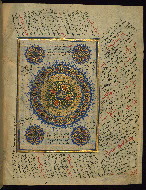
- Title: Double-page illuminated frontispiece
- Form: Frontispiece
- Label: This is the right side of a double-page illuminated frontispiece, decorated with a large circular medallion (shamsah) surrounded by four roundels. The area within the frame and the margins contains explanations of the number of readings in various chapters according to various reciters.
fol. 6b:
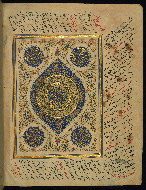
- Title: Double-page illuminated frontispiece
- Form: Frontispiece
- Label: This is the right side of a double-page illuminated frontispiece, decorated with a large medallion surrounded by four roundels. The margins contain explanations of the number of readings in various chapters according to various reciters.
fol. 7b:
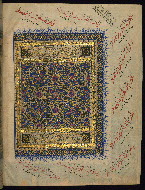
- Title: Double-page illuminated frontispiece
- Form: Frontispiece
- Label: This is the right side of a double-page illuminated frontispiece with an inscription in the cartouches in gold reading: innahu la-Qurʾān karīm ... nazīl min rabb al-ʿālamīn (Chapter 56 [Sūrat al-wāqiʿah], verses 77-80). Written in the margins is the phrase alayhim andhartahum am lam tunzirhum (Chapter 2 [Sūrat al-baqarah], verse 6) in the transmission (riwāyat) of Qālūn, written obliquely and repeated eighteen times.
fol. 8b:
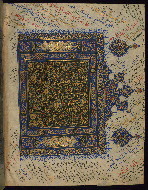
- Title: Double-page illuminated incipit
- Form: Incipit
- Label: This is the right side of a double-page illuminated incipit introducing chapter 1 (Sūrat al-fātiḥah). The verses are written in gold muḥaqqaq script outlined in black. Vocalization is in red, and counters are filled in in red and green. The ground is richly decorated with floral motifs. The margins contain various phrases and words with explanations of their readings according to different reciters.
fol. 9b:
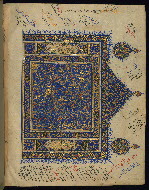
- Title: Double-page illuminated incipit
- Form: Incipit
- Label: This is the right side of a double-page illuminated incipit introducing chapter 2 (Sūrat al-baqarah), written in gold muḥaqqaq script outlined in black. Vocalization is in red, and counters are filled in in green. The ground is decorated with floral motifs. The margins contain various phrases and words with explanations of their readings according to different reciters.
fol. 137b:
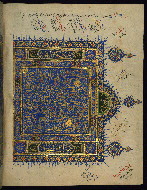
- Title: Double-page illuminated incipit
- Form: Incipit
- Label: This is the right side of a double-page illuminated incipit for chapter 7 (Sūrat al-aʿrāf). The text is inscribed in gold muḥaqqaq script, outlined in black with vocalization in blue and counters filled in in red and green. The ground is richly decorated with floral motifs. The margins contain various phrases and words with explanations of their readings according to different reciters.
fol. 274b:
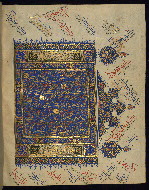
- Title: Double-page illuminated incipit
- Form: Incipit
- Label: This is the right side of a double-page illuminated incipit introducing chapter 19 (Sūrat Maryam). The text is written in gold muḥaqqaq script, outlined in black with vocalization in red and counters filled in in red and green. The ground is decorated with floral motifs. The margins contain various phrases and words with explanations of their readings according to different reciters.
fol. 408b:
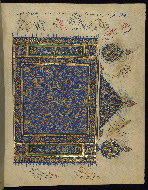
- Title: Double-page illuminated incipit
- Form: Incipit
- Label: This is the right side of a double-page illuminated incipit introducing chapter 38 (Sūrat Ṣād) in gold muḥaqqaq script, outlined in black with vocalization in red and counters filled in in red and green. The ground is decorated with floral motifs. The margins contain various phrases and words with explanations of their readings according to different reciters.
fol. 550a:
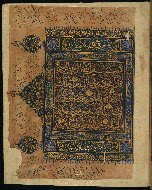
- Title: Double-page illuminated incipit
- Form: Incipit
- Label: This is the left side of a double-page illuminated incipit introducing the final chapter, chapter 144 (Sūrat al-nās). The text is written in gold muḥaqqaq script, outlined in black with vocalization in blue and counters filled in in red. The ground is decorated with floral motifs. The margins contain various phrases and words with explanations of their readings according to different reciters.
The binding is original.
Brown, gold-tooled leather (with flap); central lobed oval with pendants and cornerpieces, all with floral motifs; large border comprised of rectangular pieces with floral motifs; doublures of reddish-brown leather of similar design with filigree work on a blue ground; fore-edge flap inscribed with verses 77-80 from chapter 56 (Sūrat al-wāqiʿah)
Erased bequest (waqf) statement and stamp of Sultan ʿUthmān Khān (fol. 3a)
Seal of Sultan Bayezid II (fol. 8a)
Acquired from Mr. Dikran G. Kelekian
Principal cataloger: Gacek, Adam
Catalogers: Landau, Amy; Smith, Sita
Copy editor: Bockrath, Diane
Conservators: Jewell, Stephanie; Quandt, Abigail
Contributors: Barrera, Christina; Emery, Doug; Herbert, Lynley; Noel, William; Simpson, Shreve; Tabritha, Ariel; Toth, Michael B.; Valle, Chiara
The Walters Art Museum
Licensed for use under Creative Commons Attribution-NonCommercial-ShareAlike 3.0 Unported Access Rights, http://creativecommons.org/licenses/by-nc-sa/3.0/legalcode. It is requested that copies of any published articles based on the information in this data set be sent to the curator of manuscripts, The Walters Art Museum, 600 North Charles Street, Baltimore MD 21201.